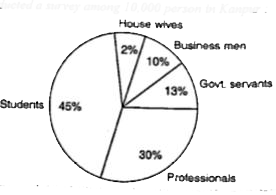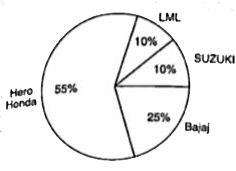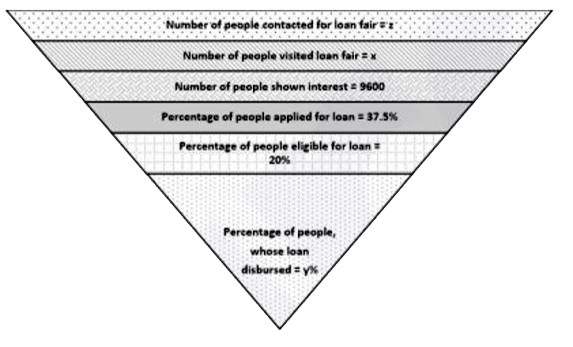In a group of 50 people, two sets were conducted, one for diabetes and one for blood pressure. 30 people were diagnosed with diabetes and 40 people were diagnosed with high blood pressure. What is the minimum number of people who were having diabetes and high blood pressure ?
0
10
20
30
The correct Answer is:C
n(T)=50
n(D)=30
n(H)=40
n(T)=n(D)+n(H)−n(DnH)
50=30+40−n(D∩H)
n(D∩H)=70−50=20
Number of people having diabetes and high blood pressure=20
Topper's Solved these Questions
Similar Questions
Knowledge Check
In a group of 50 people, two tests were conducted, one for diabetes and one for blood pressure. 30 people were diagnosed with diabetes and 40 people were diagnosed with high blood pressure. What is the minimum number of people who were having diabetes and high blood pressure?
A0B10C20D30Assertion : Generally old people have hiher blood pressure.
Reason : Arterial diameter increases with Age.AIf both Assertion & Reason are True & the Reason is a correct explanation of the Assertion .BIf both Assertion & Reason are True but Reason is not a correct explanation of the AssertionCIf Assertion is True but the Reason is False.DIf both Assertion & Reason are false.A marketing company conducted a survey among 10,000 person in Kanpur :


It was observed that some people have more than one bike but from only one company i.e., a particular person can have more than one bike of HeroHonda, but not from bajaj etc. and vice versa. Thus there were total 12,000 bikes with 10,000 persons used for survey. There are only four compaies operating in this market.
If the number of people who drive one, two and three bikes are in the ratio 15 : 3 : 1 what is the number of people in the survey who do not drive even a single bike ?A750B400C600D500
Study the following information carefully and answer the given questions:
The diagram, given below shows the data related to loan fair. In total z number of people contacted for a loan fair, from which x number of people visited loan fair and 9600 people shown interest for a loan. Out of the total number of people shown interest for a loan only 32% applied for the loan. Out of the total number of people applied for the loan, only 20% are eligible for a loan. Out of the total number of people eligible for a loan, loan of only y% people are disbursed

Loan of 40% of the people did not disbursed who were eligible for a loan, then find the ratio of the number of people, who shown interest and the number of people, whose loan disbursed.
View SolutionStudy the following information carefully and answer the given questions.
Seven people i.e. K, L, M, N, O, P and Q were born in different years i.e. 1973, 1978, 1982, 1985, 1992, 1993 and 1996. All of them like different colours i.e. Red, Black, Green, White, Blue, Orange and Yellow. All the information is not necessarily in the same order.
(Note: Consider the base year as 2021)
O was born after the one who likes Red colour but neither likes Green nor Blue colour. One person sits between K and the one who likes the Blue colour. The difference between the ages of those who like Black and Green colour is 3 years. The difference between the age of P and the one who likes White colour is 4 years. Three people were born between M and the one who likes Yellow colour. L was born just after the one who likes the Orange colour. Three people were born between L and the one who likes Black colour. Two people were born between the one who likes Blue colour and P. The age of K is a perfect square of a number. The number of people born after the one who likes White colour is same as the number of people born before M. N was born before L but neither likes Orange nor Blue colour.
How many people were born between O and the one who likes Green colour?
View SolutionStudy the following information carefully and answer the given questions.
Seven people i.e. K, L, M, N, O, P and Q were born in different years i.e. 1973, 1978, 1982, 1985, 1992, 1993 and 1996. All of them like different colours i.e. Red, Black, Green, White, Blue, Orange and Yellow. All the information is not necessarily in the same order.
(Note: Consider the base year as 2021)
O was born after the one who likes Red colour but neither likes Green nor Blue colour. One person sits between K and the one who likes the Blue colour. The difference between the ages of those who like Black and Green colour is 3 years. The difference between the age of P and the one who likes White colour is 4 years. Three people were born between M and the one who likes Yellow colour. L was born just after the one who likes the Orange colour. Three people were born between L and the one who likes Black colour. Two people were born between the one who likes Blue colour and P. The age of K is a perfect square of a number. The number of people born after the one who likes White colour is same as the number of people born before M. N was born before L but neither likes Orange nor Blue colour.
How many people are elder than the one who likes Red colour?
View SolutionStudy the following information carefully and answer the given questions.
Seven people i.e. K, L, M, N, O, P and Q were born in different years i.e. 1973, 1978, 1982, 1985, 1992, 1993 and 1996. All of them like different colours i.e. Red, Black, Green, White, Blue, Orange and Yellow. All the information is not necessarily in the same order.
(Note: Consider the base year as 2021)
O was born after the one who likes Red colour but neither likes Green nor Blue colour. One person sits between K and the one who likes the Blue colour. The difference between the ages of those who like Black and Green colour is 3 years. The difference between the age of P and the one who likes White colour is 4 years. Three people were born between M and the one who likes Yellow colour. L was born just after the one who likes the Orange colour. Three people were born between L and the one who likes Black colour. Two people were born between the one who likes Blue colour and P. The age of K is a perfect square of a number. The number of people born after the one who likes White colour is same as the number of people born before M. N was born before L but neither likes Orange nor Blue colour.
Four of the following five are alike in a certain way and hence form a group. Which is the one that does not belong to that group?
View SolutionStudy the following information carefully and answer the given questions.
Seven people i.e. K, L, M, N, O, P and Q were born in different years i.e. 1973, 1978, 1982, 1985, 1992, 1993 and 1996. All of them like different colours i.e. Red, Black, Green, White, Blue, Orange and Yellow. All the information is not necessarily in the same order.
(Note: Consider the base year as 2021)
O was born after the one who likes Red colour but neither likes Green nor Blue colour. One person sits between K and the one who likes the Blue colour. The difference between the ages of those who like Black and Green colour is 3 years. The difference between the age of P and the one who likes White colour is 4 years. Three people were born between M and the one who likes Yellow colour. L was born just after the one who likes the Orange colour. Three people were born between L and the one who likes Black colour. Two people were born between the one who likes Blue colour and P. The age of K is a perfect square of a number. The number of people born after the one who likes White colour is same as the number of people born before M. N was born before L but neither likes Orange nor Blue colour.
What is the difference between the age of Q and the one who likes Orange colour?
View Solution
